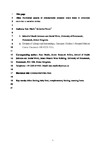Nutritional aspects of commercially prepared infant foods in developed countries: a narrative review
| dc.contributor.author | Maslin, Kate | |
| dc.contributor.author | Venter, C | |
| dc.date.accessioned | 2018-05-10T10:50:13Z | |
| dc.date.available | 2018-05-10T10:50:13Z | |
| dc.date.issued | 2017-06 | |
| dc.identifier.issn | 0954-4224 | |
| dc.identifier.issn | 1475-2700 | |
| dc.identifier.uri | http://hdl.handle.net/10026.1/11484 | |
| dc.description.abstract |
<jats:title>Abstract</jats:title><jats:p>Nutritional intake during infancy is a critical aspect of child development and health that is of significant public health concern. Although there is extensive research on breast-feeding and timing of solid food introduction, there is less evidence on types of solid foods fed to infants, specifically commercially prepared infant foods. The consumption of commercially prepared infant foods is very prevalent in many developed countries, exceeding the consumption of homemade foods in some situations. Although these food products may have practical advantages, there are concerns about their nutritional composition, sweet taste, bioavailability of micronutrients, diversity of ingredients and long-term health effects. The extent that the manufacturing, fortification and promotion of these products are regulated by legislation varies between countries and regions. The aim of the present narrative review is to investigate, appraise and summarise these aspects. Overall there are very few studies directly comparing homemade and commercial infant foods and a lack of longitudinal studies to draw firm conclusions on whether commercial infant foods are mostly beneficial or unfavourable to infant health.</jats:p> | |
| dc.format.extent | 138-148 | |
| dc.format.medium | Print-Electronic | |
| dc.language | en | |
| dc.language.iso | eng | |
| dc.publisher | Cambridge University Press (CUP) | |
| dc.subject | Infant feeding | |
| dc.subject | Baby food | |
| dc.subject | Complementary feeding | |
| dc.subject | Weaning foods | |
| dc.title | Nutritional aspects of commercially prepared infant foods in developed countries: a narrative review | |
| dc.type | journal-article | |
| dc.type | Journal Article | |
| dc.type | Review | |
| plymouth.author-url | https://www.webofscience.com/api/gateway?GWVersion=2&SrcApp=PARTNER_APP&SrcAuth=LinksAMR&KeyUT=WOS:000401584500010&DestLinkType=FullRecord&DestApp=ALL_WOS&UsrCustomerID=11bb513d99f797142bcfeffcc58ea008 | |
| plymouth.issue | 1 | |
| plymouth.volume | 30 | |
| plymouth.publication-status | Published | |
| plymouth.journal | Nutrition Research Reviews | |
| dc.identifier.doi | 10.1017/s0954422417000038 | |
| plymouth.organisational-group | /Plymouth | |
| plymouth.organisational-group | /Plymouth/Faculty of Health | |
| plymouth.organisational-group | /Plymouth/Faculty of Health/School of Nursing and Midwifery | |
| plymouth.organisational-group | /Plymouth/REF 2021 Researchers by UoA | |
| plymouth.organisational-group | /Plymouth/REF 2021 Researchers by UoA/UoA03 Allied Health Professions, Dentistry, Nursing and Pharmacy | |
| plymouth.organisational-group | /Plymouth/Research Groups | |
| plymouth.organisational-group | /Plymouth/Research Groups/Plymouth Institute of Health and Care Research (PIHR) | |
| plymouth.organisational-group | /Plymouth/Users by role | |
| plymouth.organisational-group | /Plymouth/Users by role/Academics | |
| dc.publisher.place | England | |
| dc.identifier.eissn | 1475-2700 | |
| dc.rights.embargoperiod | No embargo | |
| rioxxterms.versionofrecord | 10.1017/s0954422417000038 | |
| rioxxterms.licenseref.uri | http://www.rioxx.net/licenses/all-rights-reserved | |
| rioxxterms.type | Journal Article/Review |


